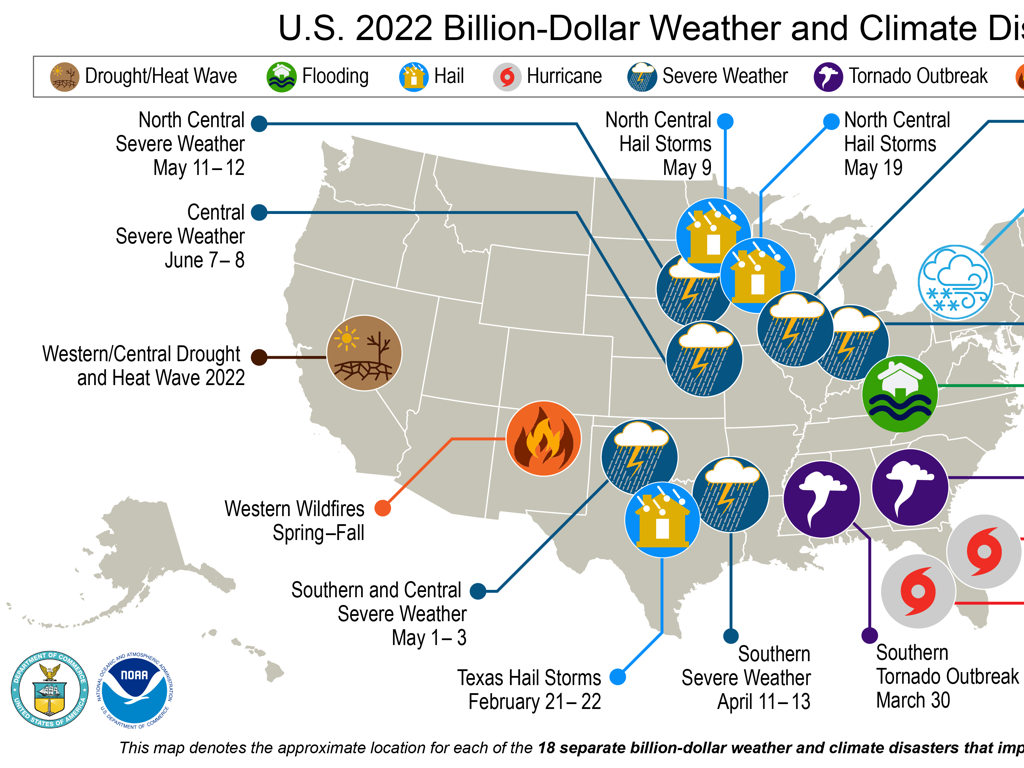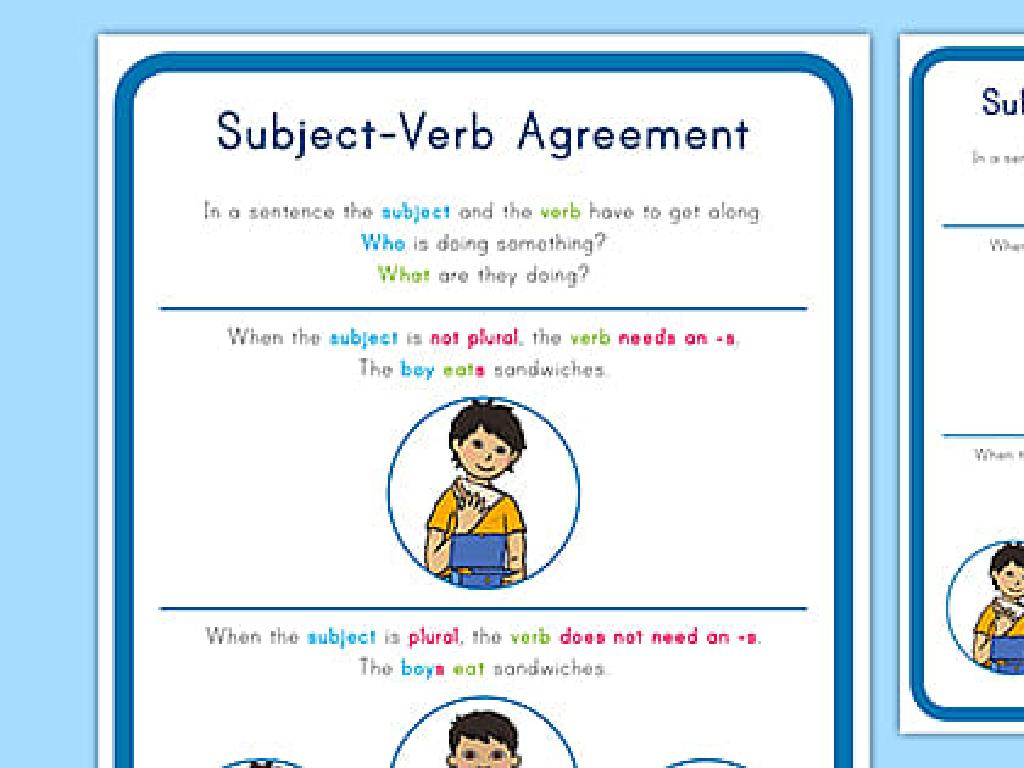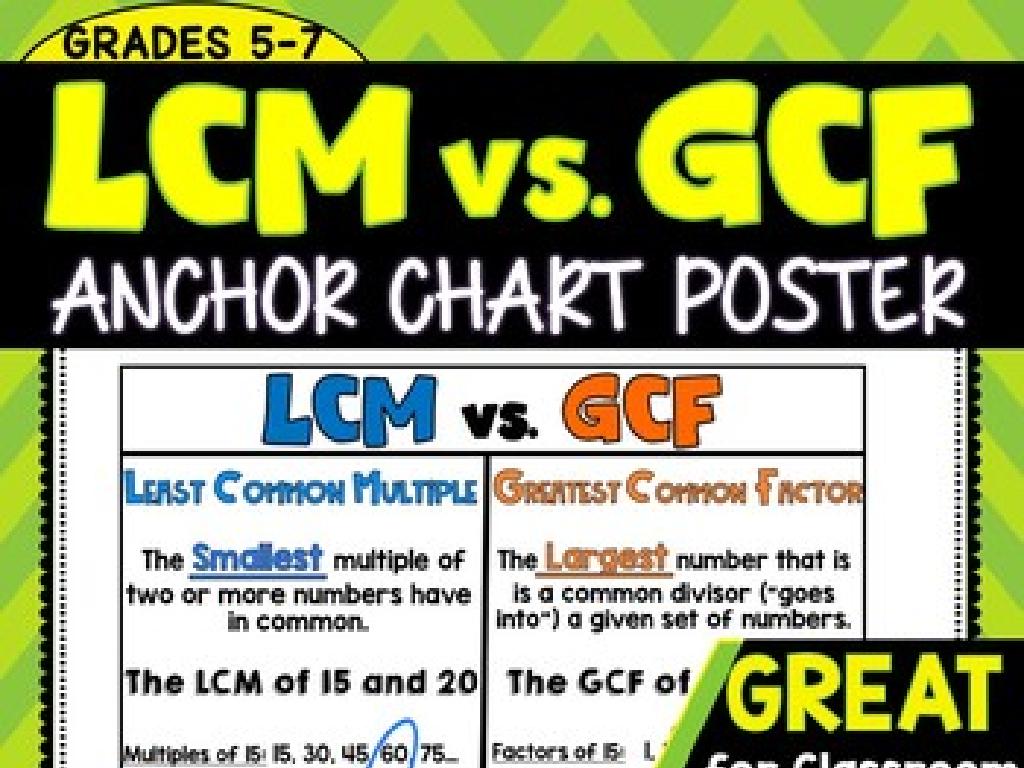Multiply Two Fractions
Subject: Math
Grade: Sixth grade
Topic: Multiply Fractions
Please LOG IN to download the presentation. Access is available to registered users only.
View More Content
Introduction to Multiplying Fractions
– Recap: What are fractions?
– Fractions represent parts of a whole.
– Multiplying fractions explained
– To multiply, simply multiply the numerators and the denominators.
– Real-life applications
– Used in cooking, crafting, and more.
– Practice problems
|
Begin with a brief review of fractions, ensuring students recall that a fraction represents a part of a whole, with a numerator and denominator. Then, introduce the concept of multiplying fractions by explaining the process of multiplying the numerators to get the new numerator and the denominators to get the new denominator. Emphasize the practicality of this skill by discussing how it’s used in everyday life, such as adjusting recipes or measuring materials for a project. Conclude with practice problems to solidify their understanding, ensuring to provide examples with different levels of complexity to cater to all students.
Visualizing Fraction Multiplication with Pie Charts
– Pie charts represent fractions visually
– Each pie chart slice can show a fraction of a whole
– Understanding multiplication with pie charts
– See how parts of one pie fit into another
– Example: Multiply 1/2 by 1/3
– Visualize 1/2 pie and 1/3 pie, then combine
|
This slide aims to help students visualize the concept of multiplying fractions using pie charts. By representing fractions as slices of pie, students can see how fractions of different sizes combine to form a new fraction. For the example, show how half of a pie chart can be further divided into thirds, and then how one of those thirds represents the product of 1/2 and 1/3. This visual method can be particularly effective for students who are visual learners and can help solidify the abstract concept of fraction multiplication. Encourage students to draw their own pie charts for different fraction multiplications to reinforce the concept.
The Rule for Multiplying Fractions
– Step 1: Multiply the numerators
– If we have 1/2 and 3/4, we multiply 1 and 3
– Step 2: Multiply the denominators
– Continuing, we multiply 2 (denominator of 1/2) and 4 (denominator of 3/4)
– Simplify the fraction if needed
– If we get 3/8, it’s already simple. But if we had 2/4, we’d simplify to 1/2
|
When teaching students to multiply fractions, start by explaining that multiplication is essentially repeated addition and that this concept extends to fractions. Demonstrate the process step by step, using clear examples. For instance, if we multiply 1/2 by 3/4, we multiply the numerators (1 and 3) to get 3, and the denominators (2 and 4) to get 8, resulting in the fraction 3/8. Emphasize the importance of simplifying fractions to their lowest terms, explaining that it makes them easier to understand and compare. Provide several examples and practice problems, and encourage students to work through them to gain confidence in multiplying fractions.
Multiplying Fractions: Step-by-Step Examples
– Example 1: Multiply 2/3 by 4/5
– Multiply numerators, then denominators: (2*4)/(3*5) = 8/15
– Example 2: Multiply 5/8 by 1/4
– Multiply across: (5*1)/(8*4) = 5/32
– Simplify the product of fractions
– Reduce fractions to simplest form if possible
– Practice with different numbers
|
This slide provides clear examples of how to multiply two fractions. Start by multiplying the numerators (top numbers) to get the new numerator, then multiply the denominators (bottom numbers) to get the new denominator. For Example 1, multiplying 2/3 by 4/5 gives us 8/15, which cannot be simplified further. For Example 2, multiplying 5/8 by 1/4 gives us 5/32, also in simplest form. Emphasize the importance of simplifying fractions whenever possible to make them easier to understand and use. Encourage students to practice with different numbers to become comfortable with the process. Provide additional examples if time allows and remind students that multiplication of fractions does not depend on the fractions having the same denominator.
Let’s Practice Multiplying Fractions!
– Multiply 3/7 by 2/5
– Step 1: Multiply the numerators (3 x 2). Step 2: Multiply the denominators (7 x 5).
– Multiply 1/2 by 3/4
– Step 1: Multiply the numerators (1 x 3). Step 2: Multiply the denominators (2 x 4).
|
This slide is designed for a class activity where students will practice multiplying two fractions. Start by solving the first problem together. Walk through each step, multiplying the numerators to get the new numerator and the denominators to get the new denominator. Simplify the answer if possible. For the second problem, guide the students through the same process and check for understanding. Provide additional problems if time allows and encourage students to try creating their own problems. This activity will help solidify their understanding of fraction multiplication.
Multiplying Fractions: Word Problems
– Apply fraction multiplication
– Real-world example: area calculation
– Find the area of a rectangle with fractional sides, e.g., 1/2 ft by 1/3 ft
– Step-by-step problem-solving
– 1. Understand the problem 2. Plan the solution 3. Solve 4. Check your answer
– Practice with diverse scenarios
|
This slide aims to consolidate students’ understanding of multiplying fractions by applying the concept to real-world situations. Start by discussing the importance of applying math to everyday problems. Use the example of calculating the area of a rectangle with fractional lengths to show practical application. Walk students through a structured approach to solving word problems: understanding what is being asked, devising a plan to find the solution, executing the plan, and finally, checking to ensure the answer makes sense. Encourage students to practice with different scenarios to gain confidence in solving word problems involving fraction multiplication.
Class Activity: Fraction Multiplication Race
– Pair up for the multiplication game
– Use fraction cards to create problems
– Each pair gets a set of cards with fractions
– Solve 5 problems to win the race
– Use multiplication to find the product
– First pair to finish wins a prize!
|
This interactive class activity is designed to reinforce the concept of multiplying two fractions. Students will pair up and use fraction cards to generate and solve multiplication problems. The first pair to correctly solve five problems wins the game. This activity encourages teamwork, quick thinking, and application of the multiplication method. Possible variations include timed rounds, tournament style play, or challenging students to create the most complex problem. Ensure that each pair understands the multiplication process and remind them to simplify their answers when possible. This is a fun way to practice and solidify their understanding of fraction multiplication.
Wrapping Up: Multiplying Fractions
– Quick recap of today’s lesson
– Practice is key to mastery
– Regular practice solidifies concepts
– Homework: 10 fraction problems
– Worksheet to reinforce learning
– Bring questions to next class
– Ready to help with any difficulties
|
As we conclude today’s lesson on multiplying two fractions, it’s crucial to emphasize the importance of practice in mastering this skill. The homework assignment consists of a worksheet with 10 problems that cover the range of examples we discussed in class. Encourage students to attempt all problems and assure them that we will review any questions they have in the next session. Remind them that making mistakes is a part of the learning process, and the goal is to learn from those mistakes. Provide guidance on how to approach each problem and suggest that they explain their reasoning for each step as they work through the problems.






